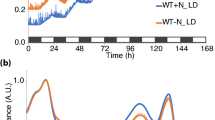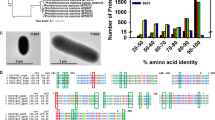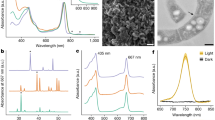Abstract
Many oxygen-evolving nonheterocystous cyanobacteria can synthesise nitrogenase1,2, but only a few are able to protect the enzyme from inhibition and denaturation by oxygen3–5. It is difficult to reconcile concomitant oxygenic photosynthesis and the obligately anaerobic process of nitrogen fixation in the remaining strains. One possibility is a temporal separation of the processes: Plectonema boryanum (U. Tex strain 594) has been shown6 to fix nitrogen and then grow oxygenically to the limits of the fixed nitrogen when incubated without combined nitrogen under N2/CO2. Growth was not extensive. Here conditions are described in which the same strain of P. boryanum will simultaneously fix nitrogen and grow extensively, fully pigmented, apparently with sufficient metabolic energy to drive nitrogen fixation.
This is a preview of subscription content, access via your institution
Access options
Subscribe to this journal
Receive 51 print issues and online access
$199.00 per year
only $3.90 per issue
Buy this article
- Purchase on Springer Link
- Instant access to full article PDF
Prices may be subject to local taxes which are calculated during checkout
Similar content being viewed by others
References
Stewart, W. D. P. & Lex, M. Arch. Microbiol. 73, 250–260 (1970).
Rippka, R. & Waterbury, J. B. FEMS Microbiol. Lett. 2, 83–86 (1977).
Gallon, J. R., Kurz, W. G. W. & LaRue, T. A. in Nitrogen Fixation by Free-Living Microorganisms (ed. Stewart, W. D. P.) 159–173 (Cambridge University Press, New York, 1975).
Carpenter, E. J. & Price, IV, C. C. Science 191, 1278–1280 (1976).
Pearson, H. W., Howsley, R., Kjeldsen, C. K. & Walsby, A. E. FEMS Microbiol. Lett. 5, 163–167 (1979),
Weare, N. M. & Brenemann, J. R. J. Bact. 119, 258–265 (1974).
Stewart, W. D. P. & Pearson, H. W. Proc. R. Soc., Lond. B175, 293–311 (1970).
Padan, E. A. Rev. Pl Physiol. 30, 27–40 (1979).
Garlich, S., Oren, A. & Padan, E. J. Bact. 129, 623–629 (1977).
Pearson, H. W. & Tomlinson, D. L. in Proc. Second Int. Symp. Photosynthetic Procaryoies (eds Codd, G. A. & Stewart, W. D. P.) 161–163 (University of Dundee, 1976).
Raboy, B., Padan, E. & Shilo, M. Arch. Microbiol. 110, 77–85 (1976).
Nagatani, H. H. & Haselkorn, R. J. Bact. 134, 597–605 (1978).
Lowry, O. H., Rosebrough, N. J., Farr, A. L. & Randall, R. J. J. biol. Chem. 193, 265–275 (1951).
Rogerson, A. C. J. Bact. 140, 213–219 (1979).
Stewart, W. D. P., Fitzgerald, G. P. & Burris, R. H. Proc. natn. Acad. Sci. U.S.A. 58, 2071–2078 (1967).
Author information
Authors and Affiliations
Rights and permissions
About this article
Cite this article
Rogerson, A. Nitrogen-fixing growth by nonheterocystous cyanobacterium Plectonema boryanum. Nature 284, 563–564 (1980). https://doi.org/10.1038/284563a0
Received:
Accepted:
Issue Date:
DOI: https://doi.org/10.1038/284563a0
This article is cited by
-
Hydrogen Generation Through Indirect Biophotolysis in Batch Cultures of the Nonheterocystous Nitrogen-Fixing Cyanobacterium Plectonema boryanum
Applied Biochemistry and Biotechnology (2010)
-
Growth characteristics of non-heterocystous cyanobacterium Plectonema boryanum with N2 as nitrogen source
Archives of Microbiology (1986)
-
Concomitant photoautotrophic growth and nitrogenase activity by cyanobacterium Plectonema boryanum in continuous culture
Nature (1980)
Comments
By submitting a comment you agree to abide by our Terms and Community Guidelines. If you find something abusive or that does not comply with our terms or guidelines please flag it as inappropriate.



